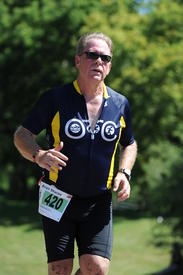Kayak Triathlon?
Options

BrianSharpe
Posts: 9,247 Member
In the past couple of years I've signed up for a sprint tri and changed to a duathlon for the simple reason that my swimming sucks, running and biking are easy but I just seem to have a mental block about swimming (even though I love the water - especially scuba diving but that doesn't seem to be an option) so it has occurred to me that a canoe or kayak tri may be an alternative (feel free to suggest I just suck it up and get into the pool too.....) as I've done both in the past and live minutes away from a river that would be very suitable for training / recreational kayaking.
The question is....where do I start in terms of selecting a kayak? What features / properties would I be looking for in a suitable kayak (without spending a bazillion$$)? Any suggested training resources?
Thanks in advance for your input.
The question is....where do I start in terms of selecting a kayak? What features / properties would I be looking for in a suitable kayak (without spending a bazillion$$)? Any suggested training resources?
Thanks in advance for your input.
0
Replies
-
I have an RTM Tempo right now which I really enjoy- I think with the seat and paddle I have just over $1000 wrapped up in it.
http://rtmkayaks.com/products/sit-on-top/tempo
http://rtmkayaks.com/products/sit-on-top/midway
I tested out both the RTM Midway and Tempo because they were both kind of a hybrid sit-on-top that actually had some dry storage and were not so wide and clunky. I like a sit-on-top more than a sit-inside because I enjoy swimming from my kayak and with a SOT you can get in and out fairly easily in deep open water. The midway was a little faster but a lot more tippy so I chose the Tempo. Whatever you get you really need to test in the water first.
Like most things kayak options boil down to which features are more important to you. Longer boats track better and are more efficient while shorter boats are cheaper, lighter and more maneuverable. Wider boats are more stable while narrower boats are generally faster. Hull design will also come into play with primary vs secondary stability (primary being the initial tippy feeling vs secondary the ability to hold the kayak at an angle which is called edging) Construction material makes a big difference- usually cheap=heavy (but durable) and expensive=light weight (but less impact resistant.) Where you plan on paddling makes a difference too- you would not want anything less than 12' or so for offshore but anything longer than 15' would be difficult to navigate around winding rivers. Depending how serious you are about racing- a genuinely fast and efficient boat comes at the expense of a lot of other niceties.
As far at training I would start by visiting the places in your area that sell kayaks and talk to them. A lot of times they have water days in the season where they take all the models out on a weekend day for open testing. They probably also have in house classes or at least some local contacts.0
This discussion has been closed.
